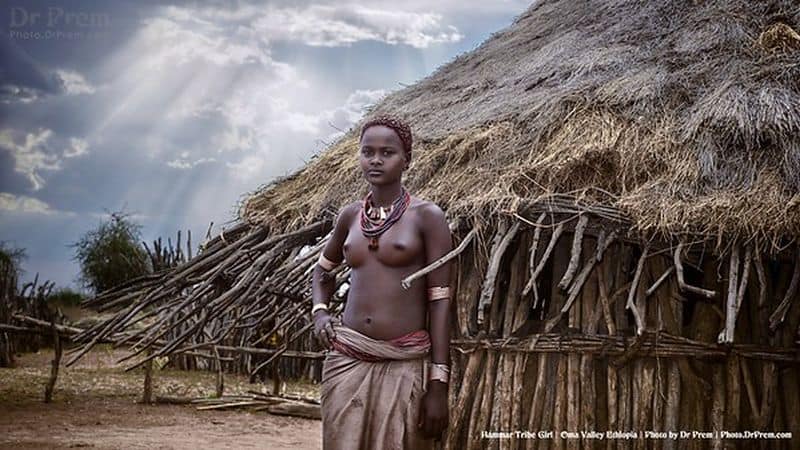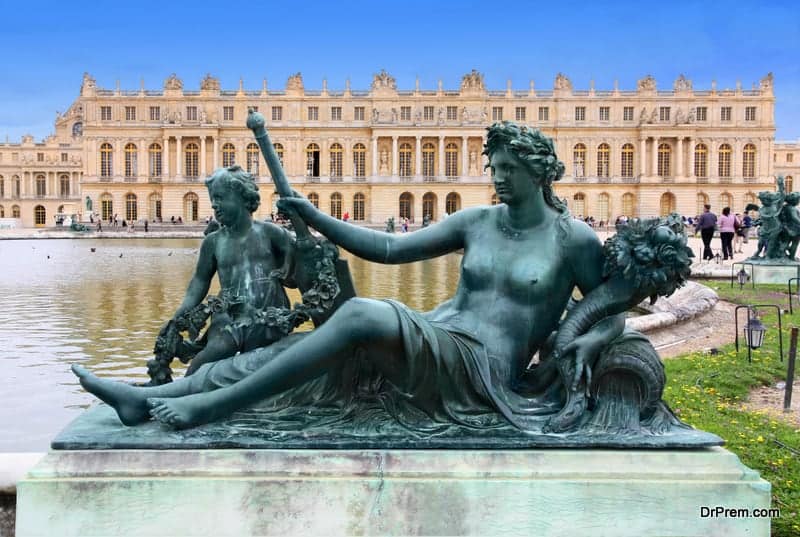My recent visit to the tribal belt of Ethiopia – especially witnessing the tribal nuances of the Hamars – was one of most gripping experiences of my life. Among several ethnic groups belonging to the Land of Origins, Hamars are spread across South West Ethiopia. Primarily dwelling in the Hamar Woreda region, an agriculturally productive plain land sandwiched between the hilly terrains of the Oma valley, these tribal folks actually allowed me to imagine how our ancestors would have sustained their existence in the primary stages of human civilization.
Appearances are too amazing to believe
I must say that Hamar people are quite thickset but muscular with a comparatively fairer skin compared to other African ethnic communities. The Hamar women folk, on the other hand, are considered most pretty and desirable. I was actually flabbergasted by their beauty. Their chisel chipped faces make a striking appeal against the dark complexion. I found certain uniqueness about their hair style that makes them look very different from other African tribeswomen. A popular beauty treatment among Hamar females is to thoroughly rub their hair with red ochre. Their loud headgear was something I could not help but appreciate. A weird range of hairstyles is prevalent among both the sexes. The women grow their hair to an appreciable length ending in deadlocks coated with a cakey layer of fat and clay.
Men shave a part of their scalp and put on a thick layer of clay and butter for giving the entire hairdo an appearance of a head cap. To crown it all, bird’s feathers and beads are embedded to enhance the looks. I was just amazed to see strictly tribal nuances which I didn’t find elsewhere in the world for sure. Both Hamar men and women attach great importance to a gorgeous mix of jewelry and drapery.
Unmarried females put on large and loud beaded collars made up of green and black beads and embellished goatskin. They love to wear beaded bracelets around the waist, arms and legs.
In married women, a pair of metal rims replaces the beaded collars; however, if the married woman happens to be the first wife of the Hamar man, she decks her up with a leather band and large pronounced disks in addition to two metal hoops. Undeniably, their sense of adornment was a visual treat for me.
Beliefs driven by paganism
As I found it out, Hamars are tribes driven by paganism. You would find witch doctors everywhere to explain everything around. A number of rituals are common in the Hamar society. One is the jumping over a bull; whether it’s a sport or a ritual is open to debate. Bull jumping turns an adolescent into manhood. Particularly, this vibrant display of human physical ability is unique among this tribe and possibly practiced nowhere in the world.
Tying the knots in this part of world in unique
Check Dr Prem’s Tribal Tourism Photo Gallery
Polygamy is quite in vogue and hence, the consequences are obvious. Hamar families are blessed by a number of kids. The society encourages family expansion as these kids would someday grow up and support the parents in old age.
Men are socially authorized to procure wives and the number would be decided by the sweet will of the groom. The price, locally called Dauri, would be paid in terms of 20 to 30 cattle to the bride’s family. However, the first wife will enjoy the highest level of prestige and social standing in the harem. It certainly reminds me of Mughals who once ruled the Indian subcontinent. The first wife becomes the authoritative head in the female household. She approves her husband’s subsequent marriages because the laborious household chores can be shared between the wives.
Hamar females are ritually whipped with sticks during maturity ceremonies. It is astonishing to witness the sheer intensity of enthusiasm with which the teenage girls allow their male counterparts to whip them and encourage them into womanhood. This ritual obviously was not to my liking, but the womenfolk were in least agony. They seemed to relish the ordeal in some kind of masochistic bent of mind.
Taboos: C’mon you find them in every society, don’t you?
Some of the common emotional outbursts that we experience in our society are surprisingly banned in the Hamar society. Crying, for example, is a taboo except when someone dies.
It is also a taboo for a Hamar herdsman to drink the milk, eat the meat or use the hide as a sleeping mattress, collected from the grazing animals that he has been raising. According to the Hamar pagan religion, a person identified as being ritually polluted is termed as ‘ Mingi ‘. Mixing with a Mingi is a taboo. He is a social outcast and banished forever into the forest.
Understanding the historical perspective of Hamars
Ethiopia, the land of the Hamars and other ethnic groups, is vast and incredibly diverse with contrasting cultural shades. Until date, it is one of the least explored countries of the world. I strongly disagree to common belief about this country that it is all about eternal famine and nothing else in Ethiopia. Accordingly, for remote spectators, Hamars would belong to the same state of affairs. Let me tell you that there is much more in store to fascinate a traveler. It is a beautiful country and so are its tribal inhabitants specially the Hamars. Since 3000 BC, it was an independent country making it around 5000 years old except for a brief occupation by Italy in 1930. Ethiopia was practically never under any foreign colonization and therefore, it is one of the oldest centers for human settlement.
From time immemorial, the Hamars have been cattle grazers and honey collectors. However, a couple of decade back, they hunted animals for food and have completely wiped them away from the Hamar territory. Since generations, land is free for farming and did not form a property of an individual.
Hamar population is incredibly massive
The entire Hamar population is semi nomadic and pastoral. According to the census carried out in 2007, there are around 47000 people in the Hamar ethnic community. They are pagans by religion, most of which dwell in the Debub Omo zone of the Southern Nations Nationalities and Peoples region.
Lifestyle that you’d appreciate for sure
For routine household chores, the Hamar women take an active role. Practically, they are the brains that run a Hamar family and are the masterminds that design schemes for the family’s improvement. Their duties are multifarious, which include looking after the children, cooking food for the family, keeping a close watch on the family, washing the house and fully engage in housekeeping and farming. They also collect firewood for cooking and water from nearby sources.
A pastoral way of living is the signature lifestyle of the Hamars. They are a rare breed of accomplished cattle herdsmen who rear cow, sheep and goat. They show a keen interest in agriculture as well growing maize, shorgum and pumpkin that have prolific production in the Oma valley.
Favorite food
The chief diet of Hamar tribe is porridge made out of shorgum and maize. The alien fragrance of Hamar porridge multiplied my appetite. The taste was alright but the thing that charmed me was the warm hospitality with which they served the food. Besides they are fond of honey, cheese and butter as well. They have a great liking for a local equivalent of beer called mash which the entire village drains in gallons in the evening.
Habits which are categorically peculiar to the Hamars:
Cattle raiding
Hamars live in a country where there is a fierce competition for survival. They engage in a constant tussle with the other hostile tribes of the area. There is fight for the resources and one of the highly prized possessions among these people is the ownership of cattle. Consequently, cattle raiding are highly in vogue. A man can consolidate his position in the Hamar society by killing a tribesman from a rival group over a cattle raid. The newly looted cattle are a definite addition to his wealth that enhances his social status. Habitually, they have been forced into this fierce bloodbath which has become a way of life for them. It is much easier to kill a man than a wild beast like a lion or a wild buffalo for that matter. It is a matter of valor and pride as well.
Like many a tribes walking on this planet, the Tattoo cult is prevalent among the Hamar people. Counting on the number of foes he had slaughtered, a Hamar warrior gets his chest scarified with vertical rows of shallow incisions into skin. The scar master is a highly skilful artist and his fees are substantial. A man has to wait until he had accumulated sufficient money to be able to pay off his scar master.
Challenges
The lives of Hamars are not exactly a bed of roses. It is tough, uncompromising and tempered by a throwing down the gauntlet attitude. The Hamar country is treacherous and featured with washed out roads and the Oma valley itself is famously described as Ethiopia’s ‘ Poisoned Paradise ‘. Despite the beautiful landscape, extreme heat and diseases like malaria and sleeping sickness keep tormenting people.
Ethnic rivalry
The resources are limited and need to be snatched away using brutal force, which eventually precipitates in ethnic battles. The traditional enemies of the Hamars are the Galebs and the Bumes. When they cross paths, blood baths follow. In fact, all the tribes of the Omo valley are fierce warriors and pitted against each other for existence.
The Hamar cult had a deep impression on my mind, and their constant vigil over cattle wealth to guard any assault by cattle raiders was an example of grit and patience. So, clubbed with their sometimes pompous parade of valor, the Hamars lifestyle inspires one and all to know about them even more.
Read More :
Mursi are the most fascinating and valiant Ethiopian tribes – Dr
Konsos are undeniably the most organized Ethiopian tribe
Ethiopian Dassanach tribe mesmerizes the explorer in me – Dr Prem
Ethiopia’s Karo tribe is a decent mix of amity, color and vigor




